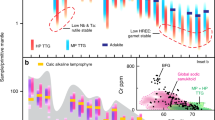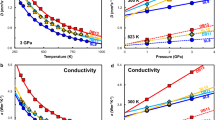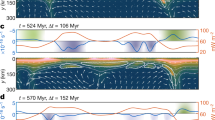Abstract
The thermal structure of the crust strongly influences deformation, metamorphism and plutonism1,2,3. Models for the geothermal gradient in stable crust predict a steady increase of temperature with depth. This thermal structure, however, is incompatible with observations from high-temperature metamorphic terranes exhumed in orogens1,4,5,6. Global compilations7 of peak conditions in high-temperature metamorphic terranes define relatively narrow ranges of peak temperatures over a wide range in pressure, for both isothermal decompression and isobaric cooling paths. Here we develop simple one-dimensional thermal models that include the effects of melt migration. These models show that long-lived plutonism results in a quasi-steady-state geotherm with a rapid temperature increase in the upper crust and nearly isothermal conditions in the middle and lower crust. The models also predict that the upward advection of heat by melt generates granulite facies metamorphism, and widespread andalusite–sillimanite metamorphism in the upper crust. Once the quasi-steady-state thermal profile is reached, the middle and lower crust are greatly weakened due to high temperatures and anatectic conditions, thus setting the stage for gravitational collapse8, exhumation and isothermal decompression after the onset of plutonism. Near-isothermal conditions in the middle and lower crust result from the thermal buffering effect of dehydration melting reactions that, in part, control the shape of the geotherm.
This is a preview of subscription content, access via your institution
Access options
Subscribe to this journal
Receive 51 print issues and online access
$199.00 per year
only $3.90 per issue
Buy this article
- Purchase on Springer Link
- Instant access to full article PDF
Prices may be subject to local taxes which are calculated during checkout


Similar content being viewed by others
References
Thompson, A. B. in Understanding Granites: Integrating New and Classical Techniques (eds Castro, A., Fernandez, C. & Vigneresse, J. L.) 7–25 (Geol. Soc. Lond. Spec. Publ. 158, 1999)
Gerbi, C. C., Johnson, S. E. & Koons, P. O. Controls on low-pressure anatexis. J. Metamorph. Geol. 24, 107–118 (2006)
Sandiford, M., Martin, N., Zhou, S. & Fraser, G. Mechanical consequences of granite emplacement during high-T, low-P metamorphism and the origin of “anticlockwise” PT paths. Earth Planet. Sci. Lett. 107, 164–172 (1991)
Patiño-Douce, A. E., Humphreys, E. D. & Johnston, A. D. Anatexis and metamorphism in tectonically thickened continental crust exemplified by the Sevier hinterland, western North America. Earth Planet. Sci. Lett. 97, 290–315 (1990)
Hollister, L. S. Metamorphic evidence for rapid (2 mm/yr) uplift of a portion of the Central Gneiss Complex, Coast Mountains, B.C. Can. Mineral. 20, 319–332 (1982)
De Yoreo, J. J., Lux, D. R. & Guidotti, C. V. Thermal modelling in low-pressure/high-temperature metamorphic belts. Tectonophysics 188, 209–238 (1991)
Pattison, D. R. M., Chacko, T., Farquhar, J. & McFarlane, C. R. M. Temperatures of granulite-facies metamorphism; constraints from experimental phase equilibria and thermobarometry corrected for retrograde exchange. J. Petrol. 44, 867–900 (2003)
Molnar, P. & Lyon-Caen, H. Some simple physical aspects of the support, structure, and evolution of mountain belts. GSA Spec. Pap. 218, 179–207 (1988)
Leitch, A. M. & Weinberg, R. F. Modelling granite migration by mesoscale pervasive flow. Earth Planet. Sci. Lett. 200, 131–146 (2002)
Harley, S. L. The origins of granulites: a metamorphic perspective. Geol. Mag. 126, 215–247 (1989)
Huerta, A. D., Royden, L. H. & Hodges, K. V. The interdependence of deformational and thermal processes in mountain belts. Science 273, 637–639 (1996)
López, S. & Castro, A. Determination of the fluid-absent solidus and supersolidus phase relationships of MORB-derived amphibolites in the range 4–14 kbar. Am. Mineral. 86, 1396–1403 (2001)
Chardon, D., Peucat, J. J., Jayananda, M., Choukroune, P. & Fanning, C. M. Archean granite-greenstone tectonics at Kolar (South India); interplay of diapirism and bulk inhomogeneous contraction during juvenile magmatic accretion. Tectonics 21 10.1029/2001TC901032 (2002)
Gibson, R. L. & Stevens, G. in What Drives Metamorphism and Metamorphic Relations? (eds Treloar, P. J. & O’Brien, P. J) 121–135 (Geol. Soc. Lond. Spec. Publ. 138, 1998)
Thompson, A. B., Schulmann, K., Jezek, J. & Tolar, V. Thermally softened continental extensional zones (arcs and rifts) as precursors to thickened orogenic belts. Tectonophysics 332, 115–141 (2001)
Kay, R. W. & Mahlburg-Kay, S. Delamination and delamination magmatism. Tectonophysics 219, 177–189 (1993)
Brown, M. in What Drives Metamorphism and Metamorphic Relations? (eds Treloar, P. J. & O’Brien, P. J) 137–169 (Geol. Soc. Lond. Spec. Publ. 138, 1998)
Hollister, L. S. & Andronicos, C. L. Formation of new continental crust in western British Columbia during transpression and transtension. Earth Planet. Sci. Lett. 249, 29–38 (2006)
Hollister, L. S., Hargraves, R. B., James, T. S. & Renne, P. R. The paleomagnetic effects of reheating the Ecstall pluton, British Columbia. Earth Planet. Sci. Lett. 221, 397–407 (2004)
Andronicos, C. L., Chardon, D. H., Hollister, L. S., Gehrels, G. E. & Woodsworth, G. J. Strain partitioning in an obliquely convergent orogen, plutonism, and synorogenic collapse: Coast Mountains Batholith, British Columbia, Canada. Tectonics 22, 1–24 (2003)
Kenah, C. & Hollister, L. S. in Migmatites, Melting and Metamorphism (eds Atherton, M. P. & Gribble, C. D.) 142–162 (Shiva Geology Series, Cheshire, UK, 1983)
Furukawa, Y., Shinjoe, H. & Nishimura, S. Heat flow in the southwest Japan arc and its implication for thermal processes under arcs. Geophys. Res. Lett. 25, 1087–1090 (1998)
Beaumont, C., Jamieson, R. A., Nguyen, M. H. & Lee, B. Himalayan tectonics explained by extrusion of a low-viscosity crustal channel coupled to focused surface denudation. Nature 414, 738–742 (2001)
Rabinowicz, M. & Vigneresse, J. L. Melt segregation under compaction and shear channeling; application to granitic magma segregation in a continental crust. J. Geophys. Res. 109, B04407, 1–20 (2004)
Morgan, J. P. Melt migration beneath mid-ocean spreading centers. Geophys. Res. Lett. 14, 1238–1241 (1987)
MacCready, T., Snoke, A. W., Wright, J. E. & Howard, K. A. Mid-crustal flow during Tertiary extension in the Ruby Mountains core complex, Nevada. Geol. Soc. Am. Bull. 109, 1576–1594 (1997)
Brown, M. & Solar, G. S. Shear-zone systems and melts; feedback relations and self-organization in orogenic belts. J. Struct. Geol. 20, 211–227 (1998)
Hutton, D. H. W. Igneous emplacement in a shear-zone termination: The biotite granite at Strontian, Scotland. Geol. Soc. Am. Bull. 100, 1392–1399 (1988)
Patchett, P. J. & Chase, C. G. Role of transform continental margins in major crustal growth episodes. Geology 30, 39–42 (2002)
Hodges, K. V., Le Fort, P. & Pecher, A. Possible thermal buffering by crustal anatexis collisional orogens: Thermobarometric evidence from Nepalese Himalaya. Geology 16, 707–710 (1988)
Stüwe, K. Thermal buffering effects at the solidus. Implications for the equilibration of partially melted metamorphic rocks. Tectonophysics 248, 39–51 (1995)
Pattison, D. R. M. & Tracy, R. J. in Contact Metamorphism (ed. Kerrick, D. M.) 105–206 (Mineralogical Society of America, Washington DC, 1991)
Shaw, C. A., Heizler, M. T. & Karlstrom, K. E. in The Rocky Mountain Region; an Evolving Lithosphere; Tectonics, Geochemistry, and Geophysics (eds Karlstrom, K. E. & Keller, G. R.) 163–184 (American Geophysical Union, Washington DC, 2005)
Turcotte, D. L. & Schubert, G. Geodynamics (Cambridge Univ. Press, Cambridge, UK, 2002)
Acknowledgements
This work was supported by the US National Science Foundation and Cornell University.
*In the print and online pdf version of this paper, it is erroneously listed as having Supplementary Information. This has been corrected on the HTML.
Author information
Authors and Affiliations
Corresponding author
Rights and permissions
About this article
Cite this article
Depine, G., Andronicos, C. & Phipps-Morgan, J. Near-isothermal conditions in the middle and lower crust induced by melt migration. Nature 452, 80–83 (2008). https://doi.org/10.1038/nature06689
Received:
Accepted:
Issue Date:
DOI: https://doi.org/10.1038/nature06689
This article is cited by
-
Growth of continental crust in intra-oceanic and continental-margin arc systems: Analogs for Archean systems
Science China Earth Sciences (2022)
-
Plutons and domes: the consequences of anatectic magma extraction—example from the southeastern French Massif Central
International Journal of Earth Sciences (2018)
-
Protracted, coeval crust and mantle melting during Variscan late-orogenic evolution: U–Pb dating in the eastern French Massif Central
International Journal of Earth Sciences (2017)
Comments
By submitting a comment you agree to abide by our Terms and Community Guidelines. If you find something abusive or that does not comply with our terms or guidelines please flag it as inappropriate.



